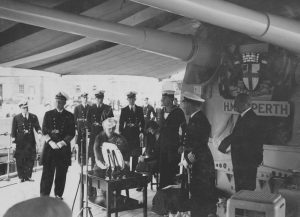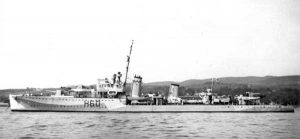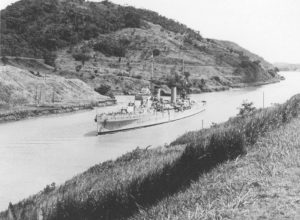- Author
- A.N. Other
- Subjects
- Ship histories and stories, Naval history, History - WW2
- Tags
-
- RAN Ships
- HMAS Perth I
- Publication
- December 2018 edition of the Naval Historical Review (all rights reserved)
By Roger Buxton
In the late northern summer and autumn of 1939 HMAS Perth and the Canadian West Coast destroyers HMC Ships Fraser, Ottawa, Restigouche and St Laurent were making the transition from peace to war, and their operations briefly coincided in the Caribbean and adjacent waters.
On 29 June 1939 the Blue Funnel steamer Autolycus arrived at Portsmouth with 500 members of the crew of Perth, a modified Achilles class cruiser, formerly HMS Amphion, that had been refitted to Australian requirements. Perthwas commissioned the same day by Captain H. B. Farncomb MVO, RAN, and officially renamed on 10 July by HRH The Duchess of Kent with the words ‘I name this ship Perth and may God bless the Perth and all who sail in her, a safe voyage and the best of luck’1It was intended that Perth return to Australia via New York and the Panama Canal. On 4 August she reached New York, firing a twenty-one gun salute on arrival, and spent the next twelve days representing Australia at the World’s Fair and enjoying American hospitality. On 16 August Perth left New York for Kingston, Jamaica, with the band playing Auld Lang Syne.2
In the summer of 1939 the forces at the disposal of the Commander-in-Chief, America and West Indies (AWI) Command, VADM Sir Sidney Meyrick3consisted of the 8th Cruiser Squadron (HM Ships Berwick, Orion and York) and two escort vessels.4As he considered that his force required more cruisers, VADM Meyrick asked the Admiralty to retainPerthon the AWI Station. Perthwas in Kingston, Jamaica and was to have sailed for the Panama Canal on 23 August, but on receiving a copy of the C-in-C’s message, Captain Farncomb cancelled sailing to await expected orders to remain on the Station. On the following day he was informed that the Australian Government had approved an Admiralty request to retain Perthon the Station for the time being, with the proviso that the decision would be reconsidered in the event of a war in the Pacific. In the evening, Captain Farncomb cleared lower deck and informed the ship’s company that Perth, on instructions from the Commonwealth Government, was now under the orders of the C-in-C AWI.5
Directed to assume the duties of Oil Fuel Protection Force, Perth spent the remainder of August and September patrolling the southern Caribbean, protecting tanker traffic from Venezuela and Trinidad and keeping a lookout for German merchant ships trying to break out from neutral ports. In an attempt to deceive these German ships into thinking that several ships were watching them, Captain Farncomb moved rapidly overnight between harbours where these ships were sheltering and sometimes shipped a dummy third funnel to disguise the identity of his ship.6

During October Perth was in the Atlantic, escorting a forty-five ship convoy half way to the United Kingdom and then visiting Bermuda. This would have been one of the last convoys from Kingston as convoys ceased to assemble there after 7 October. Later in the month Perth intercepted a signal from a German warship, probably the heavy cruiser (pocket battleship) Deutschland, but fortunately failed to make contact; she proceeded to Halifax and then Bermuda, finally returning to the Caribbean on 9 November.
The letter of proceedings from Captain (D) in Ottawa dated 15 June 1939 shows that, even at this late stage, peacetime routine continued almost undisturbed. Canadian destroyers had made a successful visit to Balboa, Canal Zone, landed a seaman with pneumonia at San Diego on return, and continued on to Esquimalt at economical speed, arriving on 28 April. Their Majesties King George VI and Queen Elizabeth were then on a visit to Canada, and as the King was to present a King’s Colour to the Royal Canadian Navy, ‘training of Colour Guard and Escort for the Royal Visit commenced forthwith’.7All four destroyers proceeded to Vancouver on 26 May for the Royal Visit. Their Majesties left Vancouver for Victoria in the ferry PrincessMarguerite escorted by the destroyers, and the departing convoy steamed at high speed between two columns of the vessels of the Fisherman’s Reserve.8
Rather surprisingly, considering the tense international situation, on 23 August the Naval Secretary approved a schedule of local port visits for September, but with an ominous final sentence ‘This programme is liable to alteration in the event of unforeseen circumstances.’9
All four ASDIC equipped Canadian destroyers were on the West Coast, and as there was considered to be no immediate threat from Japan, VADM P. W. Nelles, the Chief of Naval Staff, informed the Minister on 28 August that the destroyers should now be moved to the East Coast. Although all four destroyers were on a visit to Vancouver for the Pacific National Exhibition, on 31 August Fraser and St Laurent were ordered to sail for Halifax ‘with all convenient despatch’ (about 25 knots) and within three hours they had sailed, going straight past their home port of Esquimalt without stopping. As one of the company of Frasersaid later, ‘We left clothing ashore, rented rooms, family and unpaid bills.’10A few hours later German forces invaded Poland.
The passage south was uneventful, although on 3 September Naval Service Headquarters informed Fraser as follows:
‘Ambassador at Chile reports eight repetition eight German merchant vessels all of which are armed. Warn British shipping met and instruct them to keep clear of normal routes and take advantage of neutral waters.’11
After refuelling at San Pedro, California, which was possible in the neutral United States because Canada was not officially at war until 10 September, the ships passed through the Panama Canal into the Caribbean.
The Declaration of War did not clarify the relationship between the Canadian destroyers and the Royal Navy. The Naval Service Act provided for placing RCN ships at the disposal of the Admiralty, but Prime Minister King declined to authorise this and on 14 September an order-in-council directed RCN destroyers ‘to co-operate to the fullest extent with Royal Naval Forces’.12Once Canada was at war, C-in-C AWI asked Naval Service Headquarters if he could retain Fraserand St Laurent, then approaching Jamaica, but the ships continued on to Halifax.13
While still in the Caribbean the destroyers passed Perth and her Yeoman of Signals described the meeting as follows:
‘Sighted two destroyers on the horizon bearing down on us at high speed. On exchanging identities, we learned that they were two of HM Canadian ships. These little greyhounds looked well bounding along at 25 knots. This has become a real Dominion force now, one British cruiser, one Australian cruiser and two Canadian destroyers.’14
This anticipated events. Fraser arrived at Halifax at 2030 on 14 September and St Laurent, who had missed an alteration of course signal, at 0015 the following day. At this early stage of the war convoys were being escorted some 400 miles out to sea by the cruisers HM Ships Berwick and York andone or more destroyers. Within four days of arriving at Halifax, Fraser and St Laurent were either patrolling Cabot Strait or escorting convoys.15HMCS Saguenay had just completed a refit, which included the fitting of ASDIC, and on 23 September she departed Halifax with York and Fraser to escort convoy HX2, and was then diverted to Jamaica under C-in-C AWI orders.16

Canada had purchased the destroyer HMCS Assiniboine (ex-HMS Kempenfelt) from the UK in October 1939 and she arrived at Halifax in November. As there had been insufficient time to install the steam heating essential to operate in Canadian waters in winter, Assiniboinewas assigned to the AWI Command and left for Jamaica on 5 December to relieve Saguenay.
The remaining West Coast destroyers Restigouche and Ottawa were also despatched to Halifax, leaving Esquimalt on 15 November, but they had a problem: as Canada was now at war, they could only refuel in American (neutral) ports with sufficient fuel to take them to the nearest belligerent port, i.e. back to Esquimalt. The Report of Proceedings of Perth shows how this difficulty was overcome:
‘Friday 17 November. ‘PERTH’s’ original orders on leaving KINGSTON were to proceed to the ARUBA area, but these were cancelled later and instructions were received to fuel HM Canadian destroyers at COCOS ISLAND [in the Pacific 340nm off the coast of Costa Rica] on 25th November, and on the 18th November further instructions were received from the Commander-in-Chief America & West Indies Squadron to complete with fuel before proceeding into the Pacific ….
Wednesday 22 November.On arrival at COLON at 0740, 22nd November, the United States Naval Officer of the Guard delivered copies of the United States Neutrality Regulations affecting the Canal Zone. I signed an undertaking to respect United States Neutrality and not to embark provisions, fuel etc. without permission. The Admiral Commanding…sent a message to me that fresh provisions could be supplied without any formality…Twenty-four hours’ permission to remain in harbour was given….
‘PERTH’ was given a quick passage through and was boarded again at BALBOA by the Officer of the Guard who gave me a document indicating the time at which I must leave the Canal Zone.
Saturday 25 November. HMC Destroyers ‘OTTAWA’ and ‘RESTIGOUCHE’ were fuelled at Chatham Bay, COCOS ISLAND, 151 tons and 167 tons respectively: all that was required.
This anchorage is not a good place for fuelling: there is probably always a slight swell under the most favourable weather conditions such as obtained on this occasion.
There is a marked tidal stream across the mouth of the Bay which, when against the swell, makes conditions alongside uncomfortable for Destroyers, ‘OTTAWA’ sustained some denting of plates and the refuelling of ‘RESTIGOUCHE’ was subsequently postponed three hours until the stream had turned.
Fuelling commenced at 0900 and was not completed until 1830.’17
The log of Restigouche, anchored in 35 fathoms, notes ‘anchor bearings frequently checked’, an indication that the strong tidal stream was a matter of some concern,18

Ottawaand Restigouchepassed through the Panama Canal and continued on to Halifax. Assiniboine returned to Halifax on 3 March and was replaced in the Caribbean by Fraser.19When arrangements had been made for her replacement, Perth departed for Panama on 3 March 1940 and arrived in Sydney on 31 March. Perth was unfortunately never able to intercept an escaping German merchant ship, but Assiniboine assisted HMS Dunedin in the capture of the German merchantman Hannover in the Mona Passage and, while fighting the fires started by her crew, towed the damaged ship for four days to Kingston. Hannover was converted to the first escort aircraft carrier, HMS Audacity.
Fortune was not kind to the RAN and RCN ships involved: Perth was sunk at Sunda Strait on 1 March 1942, Ottawa was sunk by U91 in the North Atlantic on 13 September 1942 and Fraser was sunk in collision with HMS Calcutta in the Gironde Estuary on 25 June 1940. OnlyRestigouche and St Laurent survived the war.
1 Yeoman of Signals R G Roberts RAN, Age Shall Not Weary Them, Patersons Printing Press Ltd, Perth WA p 36.
2 ibid, p 52
3 Vice-Admiral Sir Sidney Meyrick KCB RN
4 Roskill, S. W., The War at Sea I, HMSO London 1954 p 48.
5 An order-in-council had been issued transferring HMAS Perthto the King’s Naval Forces.
6 G Hermon Gill, Royal Australian Navy 1939-1942, Collins/Australian War Memorial, p130.
7 HMCS St LaurentReports of Proceedings 1937-1939.Library and Archives Canada/Department of National (LAC/DND) fonds/ RG 24 vol 5684, file 141–7-5
8 A ‘navy within a navy’. Crews usually joined with their boat, which was chartered by the month. Dress was different (‘the gumboot navy’) and they could not be transferred to general service. LAC/DND RG 24 vol. 5684, file 141–7–5.
9 HMCS FraserMovements 1938-1939. LAC/DND fonds/RG 24 vol 11908, files AE 31-1-1 to AE 31-6-6.
10 Interview with LCDR P E Palmer RCN quoted by Fraser McKee and Robert Darlington, The Canadian Naval Chronicle 1939 – 1945, Revised Edition, Vanwell Publishing, St Catherines ON, 1998, p 17.
11 HMCS FraserMovements 1938-1941. LAC/DND fonds/ RG 24 vol 6810, file S 8700-353/6
12 Douglas, W. A. B. et al, No Higher Purpose, p57
13 AWI WD 31 August 1939, and 10 September 1939, quoted by W. A. B. Douglas et al, No Higher Purpose, The Official Operational History of the Royal Canadian Navy in the Second World War, 1939 –1943, Volume II, Part 1, Vanwell Publishing Ltd, St Catherines ON, 2002.
14 Roberts, R. G.,Age Shall Not Weary Them, p73.
15 LAC/DND fonds/ RG 24 vol 6810 file S 8700-323/6
16 Saguenayand Skeenawere built in the UK for the RCN and were commissioned in 1931. Built with higher than usual accommodation standards they were sometimes referred to as ‘Cadillacs’.
17 HMAS Perth Report of Proceedings during the period 4th November to 14th December 1939. Australian War Memorial
18 Log of HMCS Restigouche, at Cocos Island, for 25thday of November 1939. LAC/DND fonds/vol 7712
19 HMCSFraserhad been assigned to the AWI Command on arrival on the East Coast but had been retained in Halifax until March




